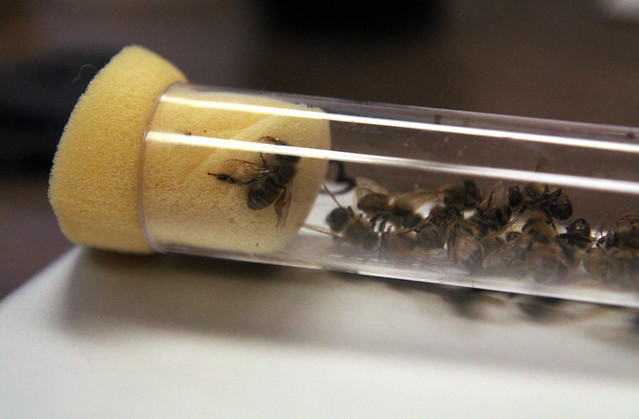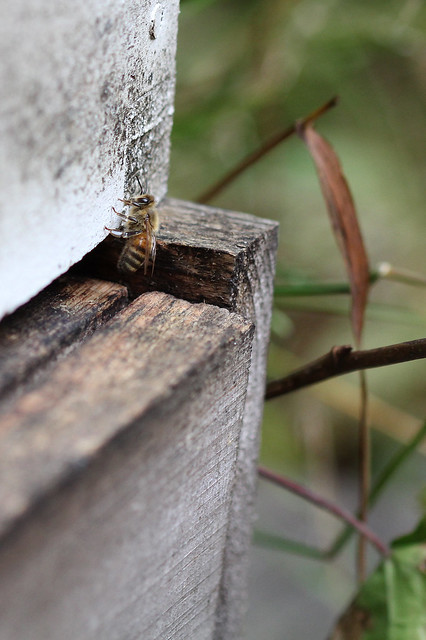
Researchers at SF State are calling on all citizen scientists to do their part in tracking bee parasites, a possible link to the disappearance of honeybees in hives across the U.S.
In 2011 entomologist John Hafernik and graduate student Christopher Quock found dead bees crawling with maggots in the northern corner of the SF State campus. The maggots came from the zombie fly, a species of fly native to the U.S. that injects eggs into bees and slowly takes over the bee’s body and mind. When researchers found bees acting in a zombie-like fashion, they were inspired to create the ZomBee Watch Project.
Colony collapse disorder was noticed in 2006 when a Pennsylvania beekeeper tending his bees in Florida woke up one November morning to find his hives abandoned.
“There are probably 150 to 200 species of bees that live in the city,” SF State researcher Gretchen LeBuhn said. LeBuhn, who understands the importance of honeybees to the nation’s food supply, started a national bee census project last year called The Great Sunflower Project.
“We always say one in every three bites of food is due to the work of honeybees,” she said.

Researchers suspect the worker bees foraging and pollinating flowers are the most at risk. But the problem of hives collapsing is not new.
“Hives have been failing for a long time, but in 2006 the rate of collapse for commercial hives increased dramatically,” Hafernik said.
The way hives are handled, the use of pesticides and pathogens found in nature all create the perfect storm for declining bee populations.
“Collecting data is our biggest problem right now,” Hafernik said.
This is where students can come in and help out SF State researchers. At night, as far as they know, zombified bees are attracted to illumination like any other insect and are usually found dead under outdoor lights. Students can create a zombee catcher out of a big Gatorade bottle, a cheap LED light and something to keep it over the bottle to attract the mind-controlled bees toward the light.
Leave it outside for the night, but be sure not to place it near an actual hive, and in the morning infected bees may be inside. Collecting a variety of bees contributes to data research.
Students who capture infected bees should upload a photo of the bee and give the location and circumstances under which it was found. Keep it isolated and wait and see if maggots begin to crawl out of the chest of the dead bee’s body.
“It is important to note the difference between honeybees and hornets,” Hafernik added.
If a litter of maggots is inside the bees, upload another photo and update the findings on the ZomBee Watch website.
“So far, we have only had a picture of what’s happening at night,” Quock said.
By tagging the bees, Quock will have a clearer idea of what’s going on during the day as well. The SF State graduate student also designed the protocol to track the infected bees to maintain data collection for the experiment.
“Typical traffic in a honeybee hive runs between 20,000 to 30,000 bees,” said Quock, who keeps the infected hive housed in a wooden box in a lab on the 8th floor of Hensill Hall. “For this project, I can comfortably fit between 2,000 to 3,000 bees.”
Quock designed the experiment so he can track and control the flow of bees during their rush hours, which are largely in the morning and at night. Tracking chips, which look like glitter and cost 25 cents a piece, are glued to the backs of about 500 bees so that when they enter and exit the hive, the chips are read. A plastic bridge connecting the infected hive to the outside world is designed to make the bees walk right-side up and in a straight line so their tracking chips are read correctly.
The scanner records when and how often the bees come in and out of the hive. Quock hopes to look at this information and possibly find a behavioral link between infected zombees and healthy bees.
“We know there are zombie flies all over the U.S. We have data from as far down as Santa Barbara for bees that have been infected by the fly, but with this project we want to find out if it’s just a West Coast thing or not,” Hafernik said.
With the help of the ZomBee Watch Project, students can build their own bee catchers and help SF State researchers help track honeybee parasites.




